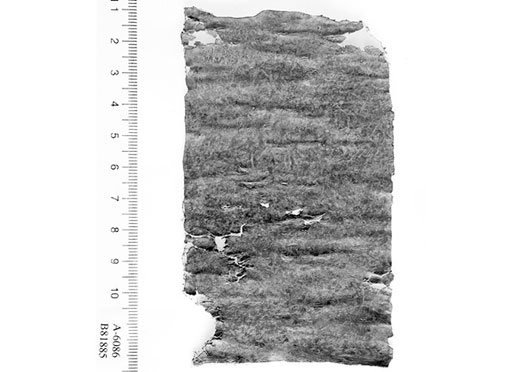Detecting an ancient talisman with a magic curse in Jerusalem
Archaeologists of the Israeli Antiquities Agency have unearthed a curse containing a curse, dating back to 1,700 years, possibly written by a witch, recently found in the ruined Roman castle in the city. David Street, Jerusalem.
This Roman castle is located in the city of David - where people lived for about 6,000 years. Located on a land of at least 2,000 square meters (about half an acre), the castle has two large courtyards lying side by side. It was used from the end of the 3rd century to 363 AD and was destroyed in the earthquakes that took place on May 18 (or 19) in May 363.
The curse is written in Greek, in which a woman named Kyrilla begs six gods to sow curse on a man named Iennys. A part of the translated curse is: Kyrilla begs the gods to "he cannot resist or make any words or actions that are detrimental to Kyrilla ."

Robert Walter Daniel, Altertumskunde Institute at the University of Cologne (Germany), said: To achieve the goal, Kyrilla combines elements of four religions. Four of the six gods Kyrilla named the gods of Greece (Hermes, Persephone, Pluto and Hecate), a god of Babylon (Ereschigal) and a god of Abrasax (Gnostic) - religion has a connection with early Christianity. In addition, the curse contains magic words like "Iaoth" - of Jewish origin. Maybe a witch created a curse for Kyrilla.
In the newly discovered artifacts, there are many gems that show the wealth of those living in the castle.
The talisman piece is located in the northwestern part of the castle in the second floor room. Artifacts near the talisman help archaeologists visualize the room when it is intact.
It seems that Iennys has a connection with this room so the new charm is placed here. Because of the curse against Iennys, it was hidden where he frequented. Maybe Iennys lived or worked in the castle or a courtroom near the second floor room, Daniel said.
Doron Ben Ami and Yana Tchekhanovets, two archaeologists of the Israel Antiquities Agency, said they discovered the rest of the mosaic and frescoes with geometric patterns and plants near the talisman. They also found the bone in the box with the word "Victory of Dionysus" - a Greek god, along with images of the sea as seahorses.

The team also discovered that the roof of the castle had the mark of the Roman 10th legion, which had been stationed in Jerusalem for a time. Ben Ami and Tchekhanovets said: "During the time of peace, the soldiers of the Roman Empire were responsible for civil construction. They built roads, ditches, brick production, etc. They produced many bricks. that the number of bricks is enough to build the city's buildings for many years after the legion leaves Jerusalem ".
The researchers also found small female statues (possibly a goddess), perhaps used in the "own cult" of the members living in the castle.
This discovery was published in detail in the journal Zeitschrift für Papyrologie und Epigraphik, specializing in studying texts on papyrus and stone inscriptions.
Reference: Discovery
- Curse in the talisman piece of 1800 years
- 5 mysterious books about magic, curse and spell of ancient times
- The most mysterious ancient curse of the earth (Part 1)
- 12 reasons to arise love for Jerusalem
- Egyptian Pharaoh and deadly curse
- Discovered an ancient tank of 1,800 years in Jerusalem
- Legend of the curse of the
- Jerusalem Citadel - Jerusalem
- The ancient temple curse is a challenge for those with the highest IQ
- Curious curses in history
- Israel found traces of ancient roads in Jerusalem
- Clarify the content of the curse from 1,700 years ago
 Discovered an ancient centipede fossil 99 million years old
Discovered an ancient centipede fossil 99 million years old Discovered bat-like dinosaurs in China
Discovered bat-like dinosaurs in China Discovered a 200-year-old bronze cannon of the coast
Discovered a 200-year-old bronze cannon of the coast Discover 305 million-year-old spider fossils
Discover 305 million-year-old spider fossils